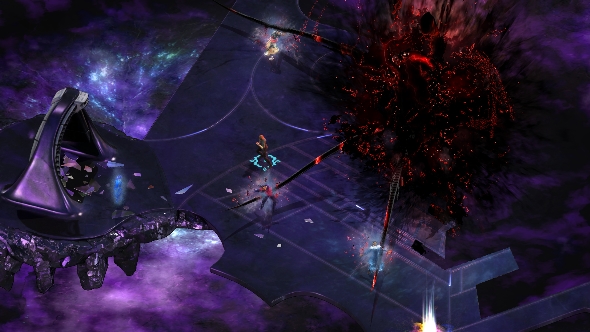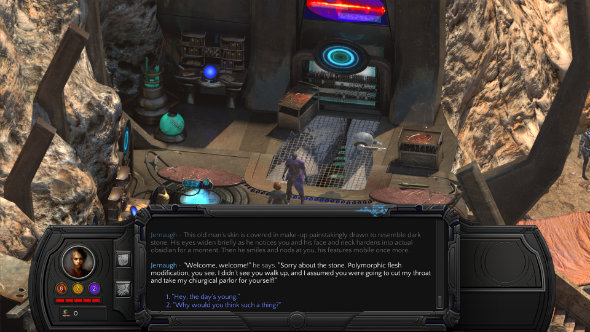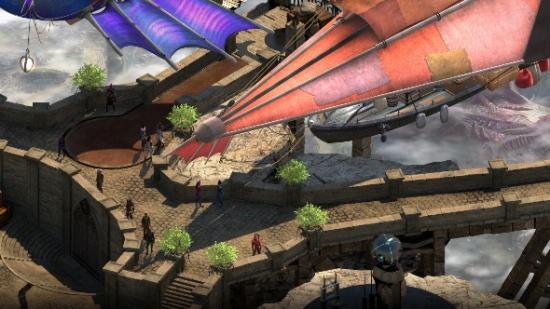What is Planescape: Torment’s legacy? It’s not an intentionally difficult question, but Torment: Tides of Numenera’s creative lead Colin McComb takes a few seconds as he considers his answer.
Related: the best RPGs on PC.
“An engaging, philosophically thoughtful and deep story that has the potential to shape people’s lives for the better,” he replies. “To show them that there are better ways, or alternate ways, of getting around difficulties in their life that they had not previously considered.”
It’s a reply worthy of a game often considered among the best ever made, and also indicates the immense pressure inXile Entertainment are under to get their spiritual successor – Torment: Tides of Numenera – right. I ask if he feels that this new games lives up to that legacy. “I’ve been on this project for four years now. It’s certainly changed my life,” he smiles.
Tides of Numenera was Kickstarted back in 2013 with a haul of over $4million, breaking the crowdfunding website’s records in the process. McComb is certainly aware of the expectations that come with a fan-financed project. “Not only do we need to fulfil our backers’ expectations of what they were expecting to fund, but we’ve also got to fulfil the legacy of Planescape Torment,” he says.
To deal with that, inXile aren’t focussing on besting the classic 1999 RPG. “We don’t want to be better than Planescape Torment,” says McComb. “It’d be cool if we were, but what we want to do is just be a companion piece. They are both cool individual stories that add together.”
The most obvious element that makes these two Torment games different is their settings. While the original takes place in the Planescape Dungeons & Dragons universe, the successor transports players to Numenera. Created by tabletop RPG veteran Monte Cook, it’s a setting that was published only months before Torment’s Kickstarter campaign began, and is itself also the product of a successful crowdfunding project. What’s more, its origins have roots in Planescape.
“Me and Monte both worked on the Planescape setting at [Dungeons & Dragons publisher] TSR, so we devoted a lot of our good creative time to helping develop that setting,” explained McComb. In the years since Planescape’s 1994 debut Cook went on to create Numenera, which he self-published in 2013. It’s a setting very much inspired by the weirdness of his earlier work on Planescape.

“Numenera itself is inherently bizarre,” says McComb, who became familiar with the world while alpha testing the tabletop rules in the months before his new Torment game was revealed to the world. “When I was looking at developing our world for Torment I suddenly realised, ‘Hey, if we’re looking for a world that’s completely unlike anything else out there right now, why are we not just looking at Numenera?’”
A licensing deal with Cook later and Torment became Tides of Numenera. It’s the perfect world for McComb’s insane ideas. “We have tried to do our best to make things really, really weird and highlight that setting,” he says. “The Numenera setting itself encourages people to be inventive, different, and strange. We wanted to honour that as much as possible. We took our base story, went through all the source material that Monte Cook sent us, and said ‘That’d be cool but what if we did this?’ I’d stretch it just a little more.”
As we’ve seen before, Tides of Numenera is a very weird game. But that weirdness has to tie into the original game at some point; this is a spiritual successor after all. One such crossing point can be found in this game’s attitude to death, which has similar ideas on the subject of finality.
“If it’s not a game-over, death will take you to something we call the labyrinth,” reveals McComb. “This is a constructed psychic mindspace, and basically you go in there, explore your mind, and uncover secrets. You’re essentially unlocking facets of yourself.”

While the labyrinth can save you from death, there’s still plenty of opportunity to wipe yourself out (“anger the wrong people or open the wrong jars” are just two examples). Should you want to stay among the living as much as possible, you’ll want to make full use of Torment’s ‘crisis system’.
Crisis points happen at specific moments in the campaign and have multiple solutions. Sometimes the most obvious path forward will be to kill whatever stands in your way, while another option may be to sneak past. But between these two opposites lie a multitude of other possibilities.
“To take an example from the very first crisis in the game, you could tell the guy who’s come to drag you back to the Order of Truth for study and dissection that you’ve just survived falling from the sky, and there’s no chance that he and his petty thugs are going to be able to beat you,” McComb details. “We wanted to make it so every crisis plays out differently based on your actions. I’ve played this first crisis twenty times now and keep discovering new things about it.”
It’s a new and exciting system that modernises the otherwise very classically styled RPG systems at place in Tides of Numenera. But McComb has been very careful to blend the new with the most important elements of yesteryear, such as multiple novels-worth of text. “We really like the extensive text, the idea that we could trust the player to be drawn in by the words and the story and the imagination,” says McComb. “We were very happy to trust the player.”
Trusting players is certainly something inXile seems to be fond of doing; they’re letting people loose in a land of city-sized space slugs, fractured gods, and dying stars, and asking them to choose their own fates. It’s an ambitious RPG like no other in development, and it’ll be the recounted tales of players that’ll be the real stories that Torment will tell. What will those narratives hold? We’ll find out next year.
